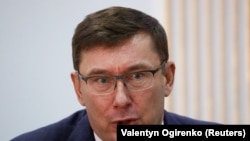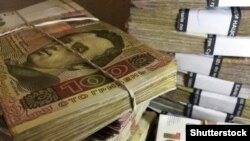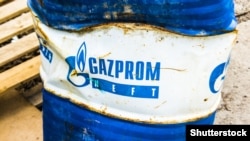Ukraine's presidential election -- and all the drama, mudslinging, and accusations between Petro Poroshenko and Volodymyr Zelenskiy that went with it -- is over.
Now it's time to get back to governing, and there are a number of issues demanding attention from President-elect Zelenskiy, a political newbie with a billowing popular mandate but virtually no established institutional base.
By all accounts, the Ukrainian people sent a strong message in this election: They are dissatisfied with both the pace of reforms and their politicians' efforts so far to root out corruption. The economy is still struggling, including with the consequences of the loss of control over Crimea to Russia. And a conflict in the country's east that has already left more than 13,000 people dead since 2014 still simmers, with Moscow's support for the armed separatists factoring into everything Kyiv does both at home and abroad.
Ukraine's president does not head the government, but the office does wield significant influence, including veto power over parliament and the authority to appoint some senior officials. The Ukrainian president is also the commander in chief of the country's armed forces, a crucial role given the ongoing conflict in the Donbas.
Here are some of the president-elect's most pressing challenges once he is inaugurated, presumably on June 3.
Corruption
Nothing looms larger than corruption. According to Transparency International's Corruption Perceptions Index 2018, Ukraine ranks 120th out of 180 surveyed nations. The problem has deep roots.
From the courts to the cop on the street, bribery is "widespread among Ukrainian public officials." According to the London-based Chatham House, tackling corruption in Ukraine will ultimately require "consensus among the elites to change the rules of the game."
Some anti-corruption efforts have not lived up to the hype. The newly created National Anti-Corruption Bureau has yet to "achieve a high-level prosecution because of the influence of vested interests over the judiciary," according to Chatham House. However, there are signs of hope. On April 11, Poroshenko announced the launch of a special corruption court, the High Anti-Corruption Court, that was a condition for a $3.9 billion loan from the International Monetary Fund (IMF). "Today, we see the result: 38 new judges proceed to perform their duties in the new court," Poroshenko wrote on Twitter at the time. It will be up to the president's office to ensure that this court's work is not impeded.
Zelenskiy has already signaled his eagerness to take on sitting officials with his election-night pledge to ensure the exit of Prosecutor-General Yuriy Lutsenko, the country's controversial top prosecutor.
But as economist Timothy Ash pointed out around the same time, many observers will also be scouring for indications that Zelenskiy is not beholden to Ihor Kolomoyskiy, the exiled oligarch whose TV station, advisers, and possibly frequent counsel have played such a major role in the 41-year-old comic's political rise.
Economy
Russia's annexation of Crimea and the conflict in eastern Ukraine have left more than 13,000 dead, tens of thousands injured, and more than a million people displaced, according to United Nations estimates. They also dealt a near death blow to Ukraine's economy. The Donbas, epicenter of the continued fighting, is also the historical heart of much of Ukraine's heavy industry. And warfare and economic growth don't mix, although there is some room for optimism.
In 2015, Ukraine's economy was shrinking, according to the World Bank, contracting by just under 10 percent. Since then, as international lending accelerated and the conflict has cooled a bit, Ukraine's economy has recovered. The IMF is predicting growth of 2.7 percent for Ukraine in 2019.
There are other encouraging signs as well. Ukraine's State Statistics Service recently reported that real wages were up 11 percent year-on-year in February. The average monthly nominal wage is 9,429 hryvnyas, or around $350. The average wage in Kyiv is up 50 percent. Foreign direct investment (FDI) remains meager at 2 percent, but "Ukraine has started reappearing on investors' radar screens," according to Andy Hunder, president of the American Chamber of Commerce in Ukraine.
Energy Independence
Russian's seizure of the Crimean Peninsula in 2014 "was very much driven by undermining Ukraine's energy and gas-diversification strategy," according to Frank Umbach, an associate director at the European Center for Energy and Resource Security (EUCERS).
The Russian takeover cost Kyiv its access to some of the vast offshore oil and gas resources in the Black Sea, estimated at 4 trillion-13 trillion cubic meters of natural gas, according to Umbach. Despite that and other major setbacks, Ukraine has made progress in decoupling itself from Gazprom, Russia's state gas giant. In February, Ukraine's state-owned energy firm Naftogaz won a landmark victory over Gazprom in a Stockholm courtroom. The judges of the Stockholm arbitration court ruled that Ukraine no longer has to buy a fixed amount from Gazprom.
Arbitrators also nullified the inflated gas prices agreed under a controversial deal struck by Yulia Tymoshenko in 2009, when she was prime minister.
Naftogaz, meanwhile, boasted in January that it had gone from importing 74 percent of its gas from Russia to getting all of its gas from elsewhere in Europe. In January, Ukraine exported its own natural gas to Europe for the first time in 15 years. In the future, experts say, Ukraine must tap into its own gas reserves. According to BP, Ukraine has 600 billion cubic meters (bci) of proven reserves, enough to meet its energy needs for 20 years. At the same time, more Ukrainians are opting for solar power. In 2018, more than 7,500 households installed solar panels on their homes, and those numbers are expected to grow.
Conflict In The East
In early 2014 when Russia annexed Crimea and began backing separatists in eastern Ukraine, Ukraine's armed forces numbered 157,000 troops. But only one brigade -- around 6,000 service members -- was considered battle-ready, according to Mykola Bielieskov, deputy director of the Institute of World Policy in Kyiv, in The National Interest. Prosecutor-General Lutsenko has since suggested that the country's armed forces "nearly collapsed" in 2014.
Around 30 volunteer militias and private armies -- some with far-right leanings, the Azov Battalion among the most notorious -- helped fill that defense vacuum.
Today, Ukraine's combined military ranks number about 250,000 active-duty troops and roughly 80,000 reservists. Ukraine has reportedly made huge strides building its own force of drones, integral to reconnaissance along the front lines.
"In the last two years since this organization has been set up, they've rapidly advanced from using dirigibles or balloons to do reconnaissance to building their own UAV systems," Lieutenant Colonel Ty Shepard, a U.S. Army National Guardsman advising a Ukrainian military command and control program, told Air And Space magazine. "And that's from zero."
They also built up their arsenal, including with a shipment of Javelin antitank missiles from the United States in 2018, and Washington might be open to supplying more. On September 1, former U.S. Ambassador to NATO and current U.S. Special Representative for Ukraine Kurt Volker suggested in an interview with The Guardian that Washington's future military aid to Kyiv could include weapon sales to Ukraine's air force and navy as well as the army.















